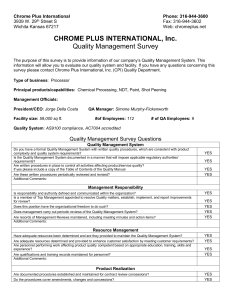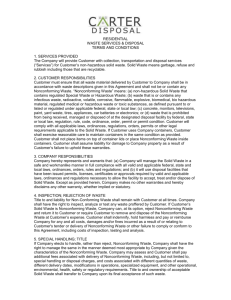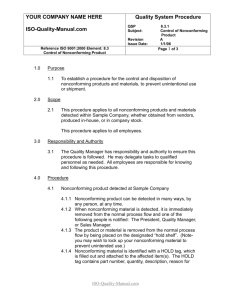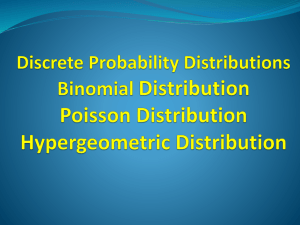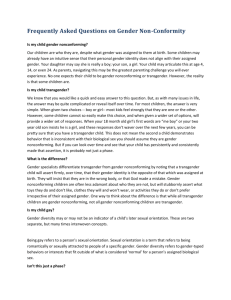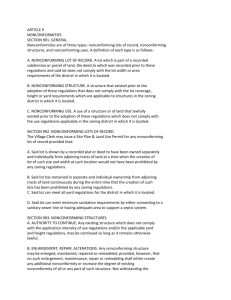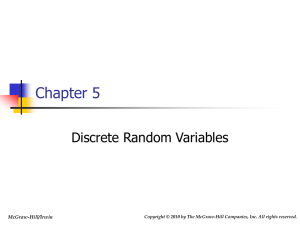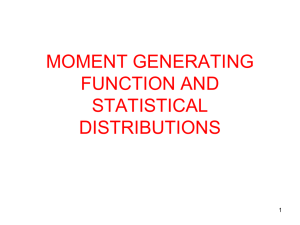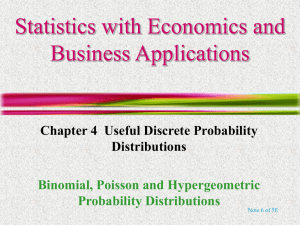Process Quality Modeling: Variation & Distributions
advertisement
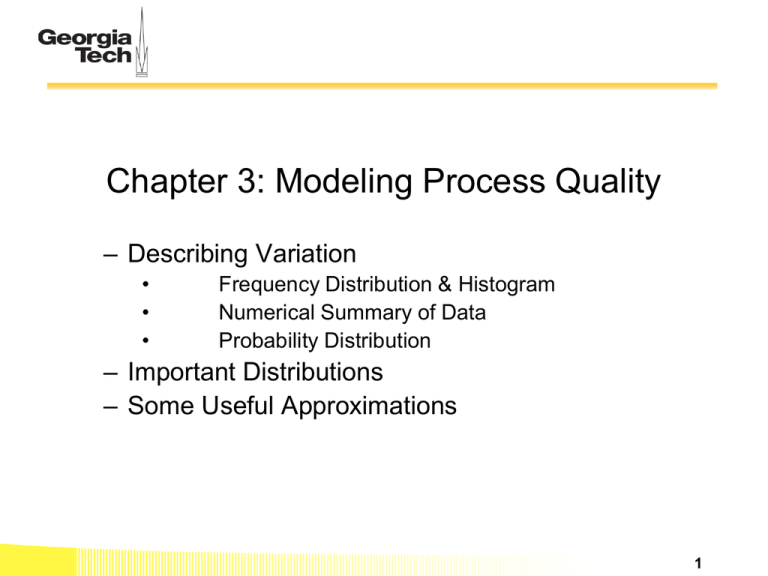
Chapter 3: Modeling Process Quality
– Describing Variation
•
•
•
Frequency Distribution & Histogram
Numerical Summary of Data
Probability Distribution
– Important Distributions
– Some Useful Approximations
1
Need for Statistics
•
•
•
Some variation is inevitable in manufacturing
processes.
Variation reduction is one of the major
objectives in quality control
Variation needs to be described, modeled,
and analyzed
How to do it?
2
Populations, Samples and Branches
of Statistics
• Population: a finite, actually existing, well-defined group of
objects which, although possibly large, can be enumerated in
theory (e.g. investigating ALL the bearings manufactured today).
• Sample: A sample is a subset of a population that is obtained
through some process, possibly random selection or selection
based on a certain set of criteria, for the purposes of
investigating the properties of the underlying parent population
(e.g. select 50 out of 1,000 bearings manufactured today).
Probability
Population
Sample
Inferential
Statistics
3
Graphically Describing Variation
Method 1: Frequency Distribution &
Histogram
An Example:
Forged Piston Rings for Engines
• Variable & Data:
– The inside diameter
(Q.C) of forged piston
rings(mm)
– 125 observations, 25
samples of 5
observations each.
Population
Sample
Observation
5
Frequency Table & Frequency
Histogram
• To construct a frequency table
1. Find the range of the data
– start the lower limit for the first bin just slightly below the smallest
data value
– b0 =min(x), bm=max(x),
2. Divide this range into a suitable number of equal intervals
– m=4 ~ 20, or N (N is the total number of observations)
3. Count the frequency of each interval
– if bi-1< x bi,
6
Histograms – Useful for large
data sets
Group values of the variable into bins, then count the
number of observations that fall into each bin
Plot frequency (or relative frequency) versus the values
of the variable
7
8
9
Interpretation based on the
Frequency Histogram
Visual Display of Three Properties of Sample Data
• Shape:
– roughly symmetric and unimodal
• The center tendency or location
– the points tend to cluster near 450.
• Scatter or spread range
– From 413 to 487
• Outliers
10
The Box Plot
(or Box-and-Whisker Plot)
11
Comparative Box Plots
12
Method 2: Numerical
Summary of Data
• Definition of Statistic:
– Let x1, …, xn be a random sample of size n from a
population and let T(x1, …, xn) be a real-valued or
vector-valued function whose domain includes the
sample space of (x1, …, xn). Then random variable
or random-vector Y = T(x1, …, xn) is called a
statistic.
• In short: a statistic is a random value (or a random
vector) calculated from a function of a sample of
data.
13
• Central Tendency: sample average/mean
n
x
x
i
i 1
n
• Scatter/variability: sample variance or sample standard deviation
n
n
ˆ S
2
2
( xi x )
i 1
n 1
2
;
ˆ S
( xi x )
i 1
n 1
2
;
• Median: A value such that at least 50% of the data values are at or
below this value and at least 50% of the data values are at or above
this value.
14
Example 2 - 1
Calculate the sample mean, median, variance, and standard
deviation of a sample of observations: x1=1, x2=3, x3=5.
If x1=101, x2=103, x3=105, is the sample variance
different from the first sample?
If x1=2.5, x2=3, x3=3.5, is the sample variance
different from the first sample?
If x3 is 500 instead of 5, what is the sample mean and
median of the sample?
15
Method 3: Probability Distribution
• A probability distribution is a mathematical model that
relates the value of the variable with the probability of
occurrence of that value in the population.
• Two types of distributions:
– Continuous: if the value being measured is expressed on a
continuous scale
– discrete: if the value being measured can only take on
certain values, e.g.. 1,2,3,4,..
f(x)
f ( x )dx 1
p(xi)
p( x i ) 1
i1
p(x4)
p(x3)
p(x5)
p(x2)
p(x6)
p(x1)
a b
x
x1 x2
p(x7)
x3 x4
x5
x6
x7
x
16
Review of Probability Distribution
Calculation
Continuous Distribution
Probability
b
P{ a x b )
f ( x )dx
Discrete Distribution
P ( x i ) p( x i )
a
Distribution mean
xf ( x ) dx
x
i
p ( xi )
i 1
Distribution variance
(x )
V (x)
2
2
f ( x ) dx
n
x
xi
i1
n
Sample variance
n
ˆ
2
S
2
(x
i
x )
i1
n1
2
(x
i 1
Sample mean
V (x)
2
) p ( xi )
2
i
Probability Density (Mass) Function
• A function f (x) (or p(xi)) is a p.d.f (or p.m.f) of a
random variable x if and only if:
– f ( x ) 0 for all x R or p ( x i ) 0 for all possible values
–
f ( x )dx 1
or
p ( xi ) 1
i
• Example 2-2: Suppose that x is a random variable with
probability distribution of
k x,
f ( x)
k x
1 x 0
0 x 1
Find the appropriate value of k. Find the mean and
variance of x. What is the probability of x>0?
Important Distributions
1. Discrete Probability Distribution
• Hypergeometric distribution
• Binomial distribution
• Poisson Distribution
2. Continuous Probability Distribution
• Normal distribution
• Chi-Square distribution
• Student t distribution
19
Hypergeometric Distribution
•
Suppose that there is a FINITE population consisting of N items. Some
number , say D (DN), of these items fall into a class of interest. A
random sample of n items is selected from the population without
replacement, and the number of items in the sample that fall into the
class of interest, say x, is observed.
D
N
Items of
Interest
x
~Hypergeomitric
Total # of items
n
(w/o replacement)
20
Hypergeometric Distribution
• Then x is a Hypergeometric random variable
with the probability distribution:
D N D
x
n
x
p(x )
N
n
nD
N
x=0, 1,…,min(n,D)
2
a
a!
b b! ( a b )!
nD
D N n
1
N
N N 1
• Used as a model when selecting a random
sample of n items without replacement from a
lot of N items of which D are noncomforming
or defective
• Excel function: HYPGEOMDIST(x,n,D,N)
21
Example: Special-purpose circuit boards are produced
in lots of size N = 20. The boards are accepted in a
sample of n = 3 if all are conforming. The entire
sample is drawn from the lot at one time and tested. If
the lot contains D=3 nonconforming boards, what is
the probability of acceptance?
22
Example: A lot of size N = 30 contains five
nonconforming units. What is the probability that a
sample of five units selected at random contains exactly
one nonconforming units? What is the probability that it
contains one or more nonconformances?
23
Binomial Distribution
• Bernoulli trial: is an experiment with two and ONLY two
possible outcomes, either a “success” (1) or a “failure” (0)
1
Y
0
with probability of p
0 p 1
with probability of 1 - p
• Examples of Bernoulli trials
– Play slot machine (outcome: win/lose)
– Toss coin (outcome: head/tail)
– Going to class (outcome: on time/late)
– Parts produced by a machine (good/defective)
Binomial Distribution
Binomial Distribution: If n identical (the probability of success on any trial
is a constant, p) Bernoulli trials are performed, the number of "success" x in n
Bernoulli trials has the Binomial distribution.
Ai {Y 1 on the i th trial },
i 1, 2 ,..., n , and X total number
n x
n – x
p (x ) = p (1 – p )
x
E (x ) = n p
V (x ) = n p (1 – p )
x = 0 ,1 ,2 ,...,n
of success
0 p 1
[N o te: V (x ) < E (x )]
Assumption:
(1) Constant probability of success p; (2) Two mutually exclusive outcomes; (3)
All trials statistically independent; (4) Number of trials n is known and constant
Application: used as a model when sampling from an infinitely large
population. The constant p represents the fraction of defective or
nonconforming items in the population
Excel Function: BINOMDIST(x,n,p,false) (True:accumulative probability)
25
26
Estimation of Binomial
Distribution Parameter
•
pˆ is the ratio of the observed number of defective or
nonconforming items in a sample x to the sample size n
pˆ
x
n
pˆ p
-> Random number
pˆ
2
p (1 p )
n
• the probability distribution of pˆ is obtained from the binomial
n x
nx
P { pˆ a } P{ a } P { x na } p (1 p )
n
x 0 x
x
[ na ]
27
Example: Sixty percent of pulleys are produced using
Lathe #1, 40% are produced using Lathe #2. What is
the probability that exactly three out of a random
sample of four production parts will come from Lathe #1
?
28
Example: A production process operates with 2% nonconforming
output. Every hour a sample of 50 units of product is taken, and the
number of nonconforming units counted. If one or more
nonconforming units are found, the process is stopped and the
quality control technician must search for the cause of
nonconforming production. Evaluate this decision rule.
29
Example: A firm claims that 99% of their products meet
specifications. To support this claim, an inspector draws a random
sample of 20 items and ships the lot if the entire sample is in
conformance. Find the probability of committing both of the
following errors:
(1) Refusing to ship a lot even though 99% of the items are in
conformance.
(2) Shipping a lot even though only 95% of the items are
conforming.
30
Example: A random sample of 100 units is drawn from a production
process every half hour. The fraction of nonconforming product
manufactured is 0.03. What is the probability that pˆ 0 . 04 if the
fraction nonconforming is actually 0.03?
31
Poisson Distribution
Poisson Distribution: the number of random events occur during a
specific “time” period with the average occurrence rate known:
p( x)
e
x
, x 0 ,1,...
x!
,
2
Examples:
• A. number of random occurrence per unit of time: number of arrivals to
McDonald ’s drive-through window from 12:00~1:00pm
• B: number of “defect” per unit of area: number of typographical errors on a
page
• C: number of “defect” per unit: number of dents on a car
Assumptions:
• The average occurrence rate (per unit) is a known as a constant
• Occurrences are equally likely to occur within any unit of time/area
• Occurrences are statistically independent
Excel Function: POISSON(x,, false) (True: cumulative probability)
32
33
Example: Arrivals of parts at a repair station are Poisson distributed,
with a mean rate of 1.2 per day. What is the probability of no
repairs in the next day? What is the probability that today the
number of parts requiring repair will exceed the average by more
than one standard deviation?
34
Exercises of Discrete Distributions (1)
What is the distribution of x in the following scenarios?
1.
2.
3.
4.
5.
A production process operates with 2% nonconforming
output. Every hour a sample of 50 units of product is taken,
and the number of nonconforming units counted as x.
60% of pulleys are produced using Lathe #1, 40% are
produced using Lathe #2. A random sample of four
production parts containing x parts coming from Lathe #1.
Circuit boards are produced in lots of size 20. The sample of
size 3 is drawn from the lot at one time and tested. The lot
contains 3 nonconforming boards and x is the number of
nonconforming boards in the sample.
Let x be the number of misprints on one page of a daily
newspaper, if the average misprints per page is 2.
1000 fish in a pond, 100 of them are tagged. x is # of tagged
fish among 5 randomly caught fish
35
6. Accidents in a building are assumed to occur randomly with
an average rate of 36 per year. There will be x accidents in
the coming April.
7. A book of 200 pages with 2 error pages. There are x error
pages in a random selection of 10 pages
8. The probability that a salesman will make a sale on one
call is 0.3. Each day, this salesman makes 10 calls. Let x
denote the number of sales made in one day.
9. The average number of flaws per running yard of a certain
type of cotton fabric is 0.01. Let x be the number of flaws
in a 100-yard roll of this fabric.
10. The probability that a basketball player will make a free
throw is 0.7. Let x denote the number of free throws he will
make in a game of seven free throw attempts.
36
Normal Distribution
f(x ) =
1
e
2 2
f(x)
–(x –) 2 /2 2
2
and – x
E (x ) =
V (x ) =
x ~ N ( , ) ;
2
Pr{ x a } Pr{ z
2
z ~ N ( 0 ,1)
a
} (
a
)
x
Pr(x+)=68.26%
Pr(2x+2)=95.46%
Pr(3x+3)=99.73%
If x1, x2 are independently normally distributed variables, then y=x1+x2
also follows the normal distribution, i.e. y~N(1+2,12+ 22)
The Center Limit Theorem: if x1, x2, …, xn are independent random variables, with
mean i and variance i2, and if y=x1+x2+…+xn, then the distribution of z
n
approaches the N(0,1) distribution as n approaches infinite.
z (y
Excel Function: NORMDIST(x,,,true)
i 1
n
i
)/
i 1
37
2
i
38
Example 3-3
2
x ~ N ( 40 , 5 )
42 . 1 40
p ( x 42 . 1) 1 p ( x 42 . 1) 1
1 0 . 42
5
39
Example 3-6: Three shafts are made and assembled in a linkage. The length of
each shaft, in centimeters, is distributed as follows:
Shaft 1: N ~ (75, 0.09)
Shaft 2: N ~ (60, 0.16)
Shaft 3: N ~ (25, 0.25)
Assume the shafts’ length are independent to each other:
(a) What is the distribution of the linkage?
(b) What is the probability that the linkage will be longer than 160.5 cm?
40
41
Chi–Squared Distribution (with
degrees of freedom )
1
f (y)
2
n/2
(n / 2)
y
( n / 2 ) 1
y
/2
(
2
e
) = ( – 1) ( – 2)... 3 • 2 • 1
2
2
2
= (
y>0
E(x) =
5 3
– 1) ( – 2)...
•
•
2
2
2 2
2
for even
for odd
V(x) = 2
The Chi-squared Distribution is associated with squared normal
random variables.
y x1 x 2 x n
2
2
2
Y follows n If x1, x2, …, xn are normally
and independently distributed random variables
The most popular use of this distribution is for testing hypotheses
about variances of samples from normal distributions.
2
42
Student t Distribution (with degrees
of freedom )
f(x ) =
1
– ( + 1 )
+ 1
2
2
x
2
1 +
2
E (x ) = 0
2 = 3 +
V (x ) =
6
n – 4
– 2
1
= 0
fo r n > 4
N o te : A s n th e d istrib u tio n o f x (d istrib u te d a s a S tu d e n t t
ra n d o m v a ria b le ) a p p ro a c h e s th a t o f a sta n d a rd n o rm a l ra n d o m
v a ria b le .
(
) = (
– 1) (
– 2 )... 3 • 2 • 1
2
2
2
= (
5
3
– 1) (
– 2 )...
•
•
2
2
2
2
fo r e v e n
2
fo r o d d
Application: If x and y are independent standard normal and chi-square
random variable respectively, then t x
is distributed as t with k
y/k
degrees of freedom.
Used for testing hypotheses about two population means.
43
F Distribution
(with u and v degrees of freedom)
u/2
u u
2
f (x)
u
2 2
x
( u / 2 ) 1
u
x
1
2
(u v ) / 2
,0 x
If w and y are two independent chi-square random
variables with u and v degrees of freedom, respectively,
then the ratio
w/u
Fu ,
y /
is distributed as F with u numerator degrees of
freedom and v denominator degrees of freedom.
Used for testing hypotheses about two population
variances.
44
45
Useful Results on Mean and Variance
If x is a random variable and a is a constant, then
E(a+x)=a+E(x)
E(a*x)=aE(x)
V(a+x)=V(x)
V(a*x)=a2V(x)
If x1, x2, …, xn are random variables,
E(x1+…+xn)=E(x1)+…+E(xn)
If they are mutually independent, and a1,…,an are constants
V(a1x1+…+ anxn)=a12V(x1)+…+an2V(xn)
46
INTERRELATIONSHIPS BETWEEN
DISTRIBUTIONS
Hypergeometric, Binomial, Poisson, Normal
Sampling without
replacement
in finite population
Hypergeometric
finite population
if n/N0.1
N: population size
n:sample size
p=D/N, n
The sum of a sequence of
n Bernoulli trials in
infinite population with
probability of success p
Number of defects
per unit
Binomial
if large n, small p <0.1, or
large n, large p > 0.9, p’=1-p
If np>10 and 0.1 ≤ p ≤ 0.9
=np, 2=np(1-p)
Poisson
if 15
= , 2=
Normal
a 0 . 5 np
Pr( x a )
np (1 p )
a 0 . 5 np
np (1 p )
b 0 . 5 np
a 0 . 5 np
Pr( a x b )
np (1 p )
np (1 p )
Pr( pˆ )
p (1 p ) / n
p
p (1 p ) / n
p
47
Example: An electronic component for a laser range-finder is produced in lots of size N =
25. An acceptance testing procedure is used by the purchaser to protect against lots that
contain too many nonconforming components. The procedure consists of selecting five
components at random from the lot (without replacement) and testing them. If none of the
components is nonconforming, the lot is accepted.
a. If the lot contains three nonconforming components, what is the probability of lot
acceptance?
b. Calculate the desired probability in (a) using the binomial approximation. Is this
approximation satisfactory'? Why or why not?
c. Suppose the lot size was N=150. Would the binomial approximation be satisfactory in
this case?
d. Suppose that the purchaser will reject the lot with the decision rule of finding one or
more nonconforming components in a sample of size n, and wants the lot to be rejected
with probability at least 0.95 if the lot contains five or more nonconforming components.
How large should the sample size n be?
48
49
Example: A textbook has 500 pages on which typographical errors could
occur. Suppose that there are exactly 10 such errors randomly located on
those pages. Find the probability that a random selection of 50 pages will
contain no errors. Find the probability that 50 randomly selected pages will
contain at least two errors.
50
Example: A sample of 100 units is selected from a production process that is
2% nonconforming. What is the probability that pˆ will exceed the true
fraction nonconforming by k standard deviations, where k = 1, 2, and 3?
51

